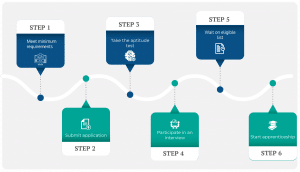The Matrigma test (aka Hogan Matrigma) developed by Assessio International, is a classic assessment that measures your cognitive ability, much like an IQ test. What makes Matrigma a powerful tool to determine or predict your job performance is its unusual non-verbal format. This is why it is essential to familiarize yourself with the test format and practice as much as you can before taking the actual test. Doing so will help you gain an advantage over other candidates. Nowadays, when most candidates do prepare to some extent for their tests, not taking a single Matrigma practice test will position you at a disadvantage in comparison to other candidates.
Did you know?
The Matrigma Test challenges test-takers with abstract visual reasoning questions in two different versions of their test: (1) classic – 35 questions in 40 minutes and (2) adaptive – as many questions as one can answer in 12 minutes. Scores are based on a scale of 1-10, and 7 or higher is considered a high score. The non-verbal nature of the test makes it easily adaptable for people in any country.
Matrigma Test Types Explained
| Classic Matrigma Test | Adaptive Matrigma Test | |
|---|---|---|
| Type of questions | Non-verbal; 3X3 matrix of geometric shapes and symbols related by some rule of logic. You must reveal the logic according to the eight visible elements and choose the correct missing element from the six answer options. | Same as the Classic Matrigma Test. |
| Time limit | 40 minutes | 12 minutes overall, 60-second maximum per question. |
| Number of questions | 35 | Unlimited, usually 15-20 questions. |
| Level of difficulty | Rising level of difficulty with some randomly easier/harder items mixed in | Difficulty changes according to your performance. Harder questions for better performers, easier questions for lower performers. |
Matrigma Preparation Strategies
1. Learn how to examine the matrix by row, by column, and by diagonals
The matrices of Matrigma are always 3-by-3 matrices. People tend to examine them as a structure that includes 3 rows and 3 columns. This is true; however, it is not the complete truth. Each matrix has two additional dimensions—the diagonals of the matrix. Often, these are the more challenging dimensions to analyze. You should look for practice materials that do not overlook this observation and provide practice questions that will make you examine each matrix through all of its dimensions.
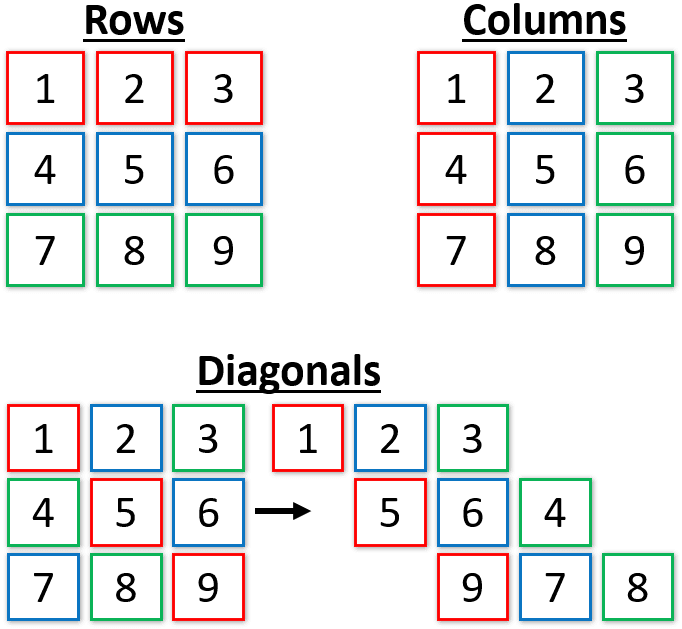
2. Learn about the most common features that change within the matrix
There are countless ways to describe changes in the matrix but you should set your mind to those changes that occur most often. A simple matrix is based on one or two pattern changes, but more complex matrices may combine 3-5 pattern changes and make it more difficult to recognize the overall pattern. The vast majority of the changes can be reduced to these pattern changes:
Color/fill changes
Objects and lines may change their color, pattern fill, or dash type. In this example, the outer part and the inner part of the circle change colors.

Quantity changes
The number of shapes or number of edges may change. In this matrix, horizontal lines are added by row and vertical lines are added by column.

Rotations and flips
The entire element or features of it may rotate or flip. In this matrix, the middle row is a 90° rotation of the top row; the bottom row is a horizontal flip of the middle row.

Structural changes
In this example, take any two elements, either by row or by column. Overlapping features disappear in the third element, and features that appear in only one of the elements appear in the third as well.

Spatial changes
In this category, certain features may move in space, get longer or shorter, or have various other manifestations. In this example, from the top-left element and either to the right or to the bottom, the two shapes “move” to opposite directions.

3. Get to know patterns of changes within the matrix
The aforementioned changes almost always happen in a certain pattern. These patterns determine the order in which the changes take place. Some examples of patterns are:
- Logic applies to columns only
- Logic applies to rows only
- Same changes by row and column
- Different changes by row and by column
You should find preparation materials that cover as many change patterns as possible so your thinking process will be flexible enough to recognize these patterns rather quickly. This will be very useful in reducing the time needed to solve each matrix, and will allow you to look for the correct answer within the options more effectively.
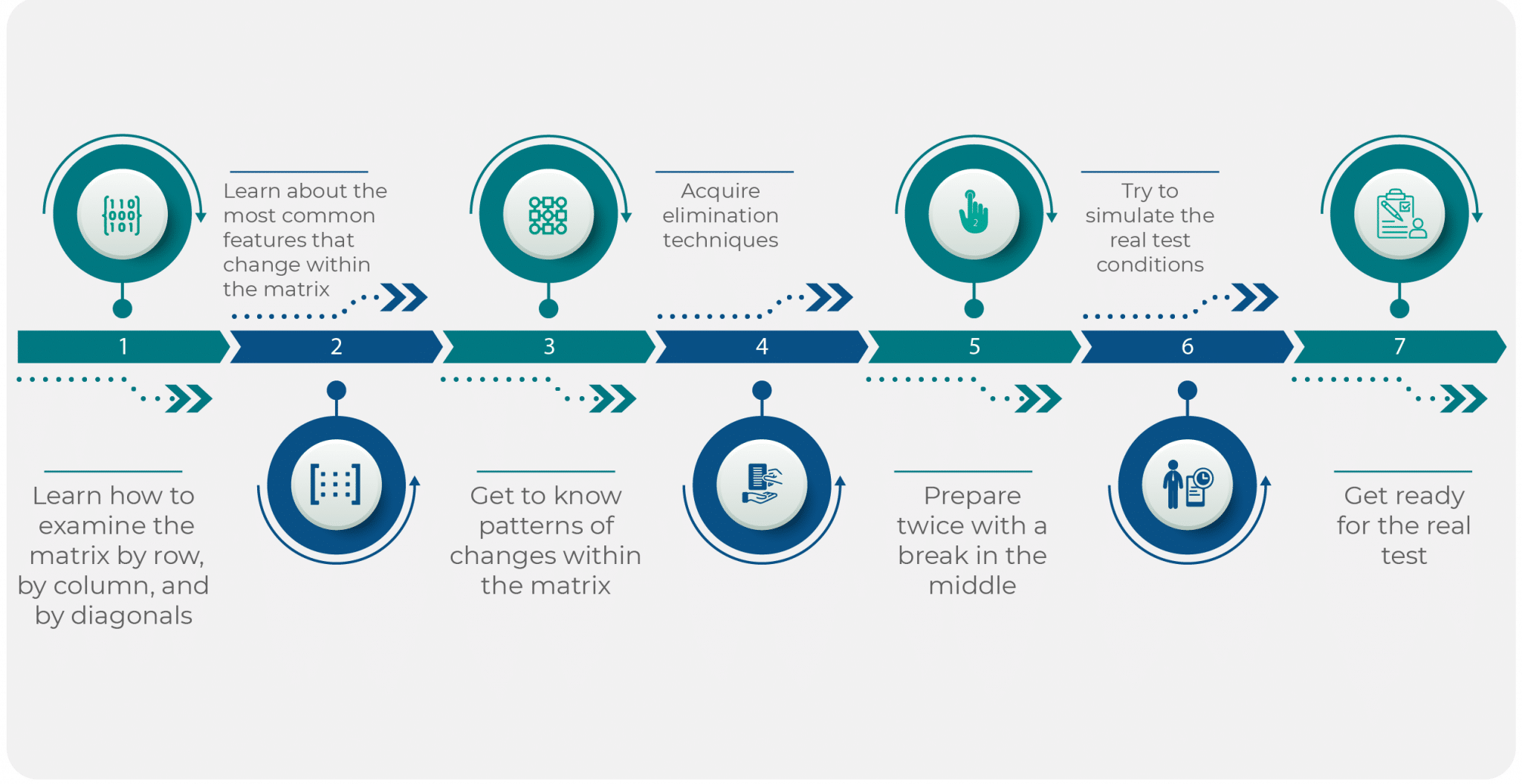
4. Acquire elimination techniques
In each Matrigma question, you will find six answers to choose from. Often, you will find that it is simpler to eliminate answers rather than to fully analyze the matrix in order to mentally come up with the correct answer. You should learn how to remove implausible answers as fast as possible so you will be left with fewer options to contemplate. This way, if you manage to eliminate all the answers but one, it has to be the correct answer, even if you haven’t completely deciphered the logic of the matrix. This is something that many of the detailed explanations on iPrep focus on.
5. Prepare twice with a break in the middle
It is very important to practice as much as possible for your test so you can take it with confidence. However, studying without a break can actually harm your test-taking success. You need the time in between to rest and get refreshed so you can process the information and give your brain a break. We recommend studying and then taking a long break, then studying again and taking a long break, and then taking the test.
However, you might also benefit from looking over some test questions right before the test to get conditioned and ready, like stretching before a race.
6. Try to simulate the real test conditions
It can be unnerving to sit down to take the real test when you have never practiced under those conditions. We recommend practicing a full-length test, at least once, so you know what to expect. Take a 40-minute, 35-question test with no interruptions and no distractions like your cellphone or other apps.
7. Get ready for the real test
Once you have taken a practice test or two under the real-life conditions you will encounter on test day, you can prepare yourself in other ways, too. Get a good night’s sleep and eat properly the day before and the morning of the test. Bring earplugs to reduce distractions. Use the bathroom before sitting down for the test and make sure you have a filled water bottle and a pillow for your back, if you think that will help you sit comfortably.
Test Features
Adaptive Matrigma Innovations
As technology advances, Assessio has published a new sophisticated version of their Classic Matrigma test—the Adaptive Matrigma. The old test has a rigid structure—35 questions with a 40-minute time limit. While the nature of the questions remains the same in the classic and adaptive tests, some aspects are significantly different:
- The Adaptive Matrigma lasts a maximum of 12 minutes and each question must be answered within 60 seconds.
- If you answer correctly, you will face a question of higher difficulty.
- If you do not answer correctly, you will get a question of lower or similar difficulty.
- The total number of questions is unlimited, yet most people will not answer more than 20-25 questions.
- The Adaptive Matrigma concludes whenever the system gains enough information to determine your overall score.
How can you know if you are about to take the Classic Matrigma or the Adaptive Matrigma? Well, you might get an invitation to take the test from your employer, which will also state the full name of the test. As of today, most employers still prefer using the classic version for their hiring process but the tide is changing toward the Adaptive Matrigma.
Supports Both Proctored & Unproctored Testing
Also known as Hogan Matrigma, the Matrigma Test has the flexibility to be administered with or without supervision. It is especially flexible because of its randomized question and response alternatives; two people will not get the same test.
Multi-Language Support
Plus, its non-verbal format makes it capable of being easily incorporated across different languages. Although it was first developed and published by Assessio in Sweden, it is now available in multiple countries and languages. Matrigma is largely used by a wide spectrum of industries around the world for recruiting employees.
A Strong Predictor of Cognitive Ability
Matrix problems are proved to be one of the most powerful tools for measuring cognitive abilities. The Matrigma Test is a reliable tool that accurately measures a person’s cognitive ability based on several years of research.
International, Nonverbal Ability Test

The Matrigma Test or Hogan Matrigma was published by the Swedish Assessio International in 2010. The test that features nonverbal format, matrix-type items, is available in over 30 countries around the world including Sweden, Norway, New Zealand, Canada, the U.S., Italy, and more. The test is identical no matter the geography.
iPREP: Concise. Focused. What you need.
Sign up
Immediate access
Practice
Online self-paced
Pass
Ace that Test!
Technical Facts
Fast Facts (tl;dr)
- Total of 35 (classic) or unlimited (adaptive) questions.
- The test is 40 minutes (classic) or 12 minutes (adaptive) long.
- Question type: 3×3 matrix questions using geometric shapes and symbols.
The Classic Matrigma Assessment comprises 35 items which you are supposed to complete within the duration of 40 minutes. Each question presents a 3×3 matrix of symbols and you need to select the missing symbol out of the six alternatives provided. Several studies have been conducted on the Hogan Matrigma, and it has been proven to be extremely reliable. In addition, the randomization of test questions allows supporting both proctored and unproctored testing. You can now find the Matrigma Assessment in more than 30 countries around the world and in more than 20 languages.
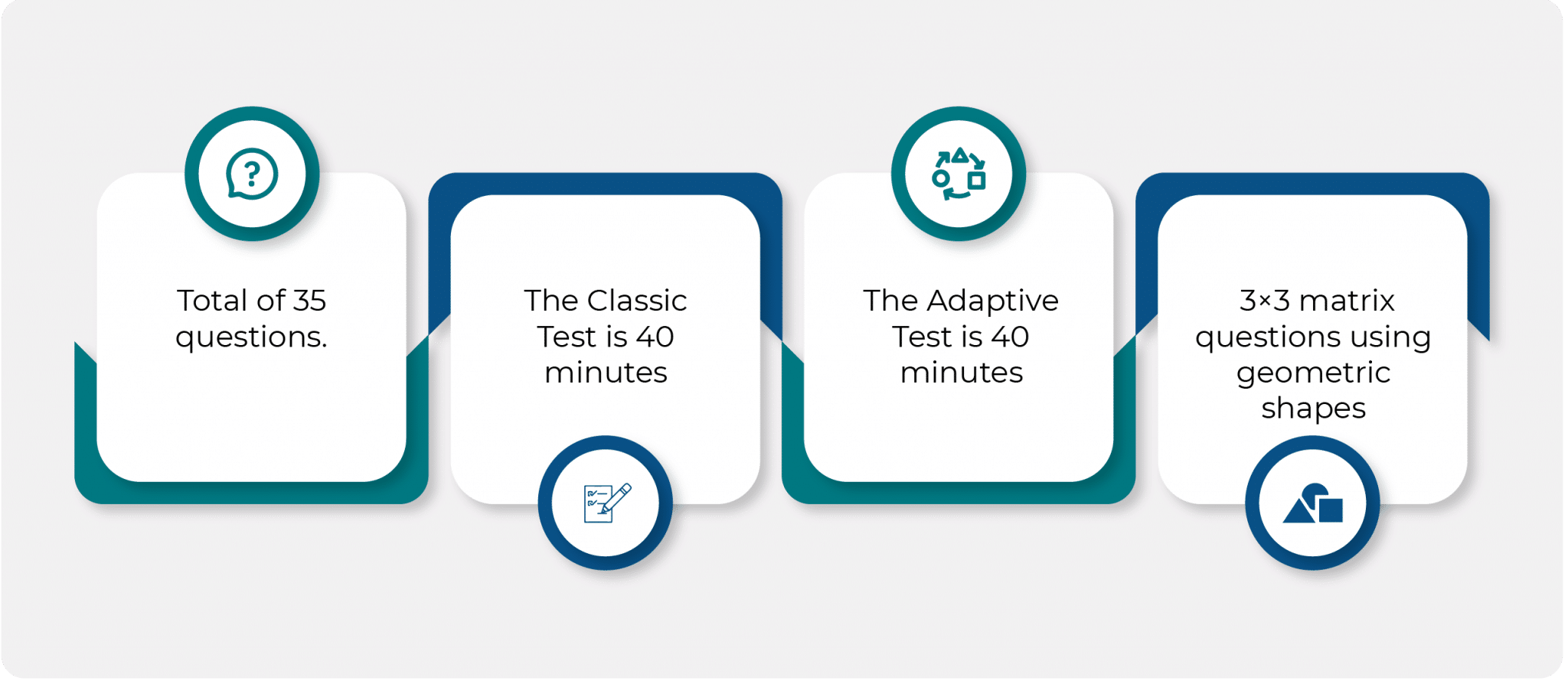
Results Scale and Interpretations
The Matrigma Test is a non-verbal test that measures your General Mental Ability or GMA in comparison to others. It measures your fundamental cognitive abilities like problem-solving skills, logical ability, and flair for spotting logical connections. The result of the Matrigma Assessment is always expressed by comparing it against the norm group or the total number of people who have taken the test.
The results are generated instantly upon completion. Your score report will place you in one of three levels of the Matrigma scale:
- Low
- Average
- High
The employer’s score report will be more detailed and will provide a numerical score and graphical representation of the score percentile. It will also include the range for passing scores, which may be different for different employers. The Adaptive Matrigma test score report takes into account the number of correct answers as well as the level of difficulty of the questions and also provides a relative percentile score.
As can be seen in the image below, the low, average and high intervals comprise 16%, 68%, and 16% respectively of the norm group that achieved a similar result. For instance, if you get a high score, your result is higher than or as high as 16% of the members of the norm group.
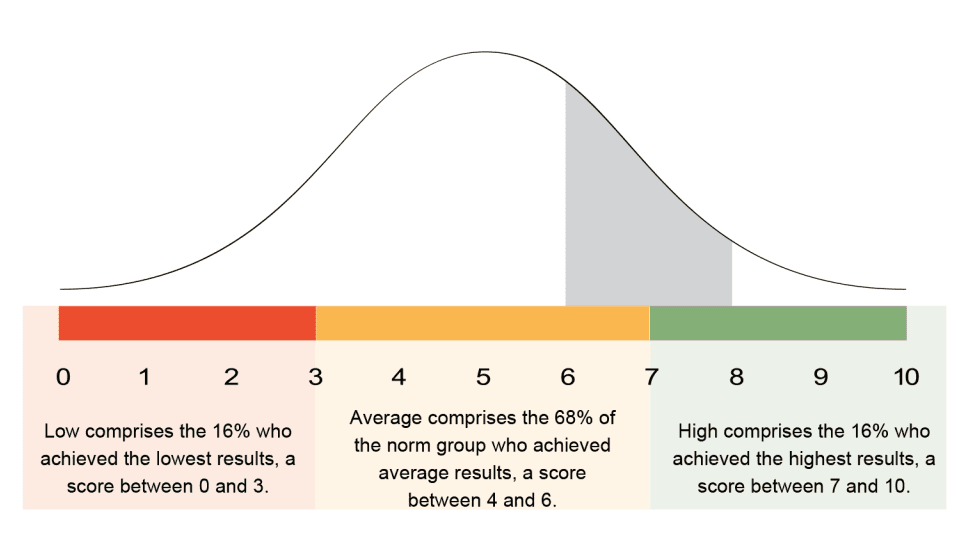
1. Low Score
A low score lies between 0 and 3. If one achieves a low score, it means that he or she has difficulty in solving problems requiring logical ability. In general, he or she is a slow and below-average performer in all kinds of jobs but will do better in jobs that demand less logical ability.
2. Average Score
An average score lies between 4 and 6 and indicates an individual’s average logical deductive ability. If your score is within the average zone, it indicates that you are a normal performer in most kinds of jobs. You are able to fulfill logical demands at work at a normal level which is neither low nor high.
3. High Score
A high score lies between 7 and 10. If you received a high score, then you are someone who solves logical issues easily. You have no difficulty in getting familiar with and performing all kinds of jobs with excellence. With a high problem-solving ability, you are an efficient and above-average performer.
Things to Keep In Mind
Your GMA score is one of the major characteristics determining your work performance. Your Matrigma Test result is all about how many problems you were able to solve within the given time. There might be various factors that would affect an individual’s true Matrigma assessment test report such as environmental disturbances during the test, psychological condition/motivation towards solving the problems,or preparedness for the test. If you are affected by one or more of these factors while taking the inductive reasoning test, you might score higher or lower than your “cognitive peer group.”
Therefore, if you are to take the test at home, make sure to create a space that is free from all disturbances. Sleeping and eating well will also help you take the test at your peak. But above all, practicing in advance is the best way of gaining an advantage.
Matrigma FAQs
The Matrigma Test is a test that measures your cognitive abilities in a non-verbal format. Companies will determine from the results whether you are a good enough candidate to move on to the next step in the hiring process.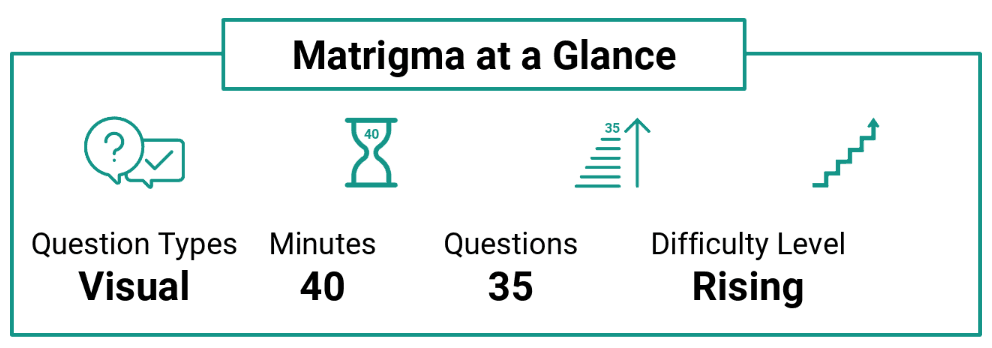
There are two types of Matrigma Tests: classic and adaptive. The classic test has 35 questions with a 40-minute time limit, and the newer, adaptive test takes a maximum of 12 minutes. Most people answer between 20 and 25 questions during that time.
The Matrigma Test is comprised of a total of between 35 questions (classic test) or unlimited (adaptive test) multiple-choice questions in matrix (non-verbal) format of geometric shapes and symbols.
You will be given either a total of 40 minutes to complete the test in Classic Matrigma or 12 minutes in the Adaptive Matrigma test with 60 seconds to answer each question. In the classic version, the difficulty level increases as the test goes on. In the adaptive version, answering correctly or incorrectly determines the difficulty of the following question.
Upon completing the test, you will receive your score which is in comparison to others who have taken the test.
Classic Matrigma is 35 questions in 40 minutes. Adaptive Matrigma lasts 12 minutes and questions keep on coming until the time elapses. You have up to 60 seconds to answer each question. In Classic Matrigma, the order of the questions is predetermined.
In Adaptive Matrigma, the difficulty level of the next question is set according to your performance on the previous question. If you solve correctly, you will be presented with a more difficult question. If you are wrong, you will be presented with a simpler question. You are not informed whether you are right or wrong during the test.
Matrigma Test Tips
- Remember to use a stopwatch in order to make sure that you complete the test within the given time limit.
- Don’t spend too much time on any particular question. No question is worth that challenge. If you spend more than one minute and you have no clue regarding the underlying logic of the matrix, take an educated guess and move on to the next question.
- Practice accurate simulation tests. Before you take the Matrigma test, learn how the questions are framed and how long the assessment will take.
- Skip difficult questions and scan for simple ones. Some questions will be more intuitive for you. Some will seem impossible. GO for the intuitive and simple ones and skip the very difficult ones to maximize the number of questions you can answer.
- Practice Matrigma sample tests in other formats. If you struggle with the concept of abstract/inductive/figural reasoning questions, find free practice tests and get to know the basics, and then get back to Matrigma-style practice tests.
- There is no penalty for wrong answers, so guess and skip if you have to. If you find yourself stuck on a question which you are not able to solve within the allocated time, move on to the next one. If you spend too much time on one question, it will negatively affect your entire test performance.
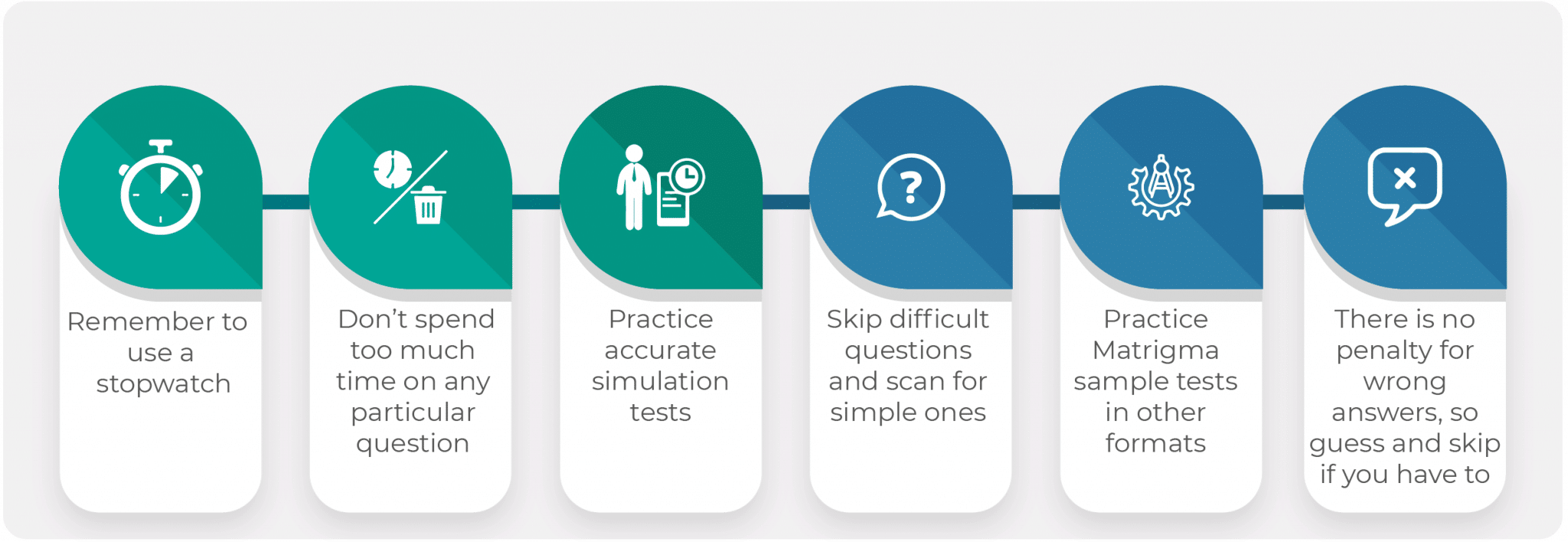
Administration
Matrigma Assessment is administered online and, therefore, you can access and take it at any time. It is suitable for both individuals and large groups. The Matrigma test is a convenient inductive reasoning test available online in more than 20 languages.
- Test location: The first attempt is often non-proctored and taken online at home. Candidates who successfully pass this online Matrigma test may be required to retake the test in a proctored environment by the hiring company, typically in their office.
- Test schedule: Matrigma tests are usually scheduled in the early recruitment stages, after your CV demonstrates that you are potentially qualified for the job.
- Test format: Multiple choice on computer. Usually taken online.
- Test materials: Test taken on computer.
- Cost: None for you. Cost is usually covered by the employer.
- Retake policy: Determined by each employer.
Test Provider
Matrigma Test or Hogan Matrigma was published by Assessio International in 2010. Assessio is a consulting organization as well as a major psychometric test publisher located in Sweden.
They have been developing such tests since 1954. The test is administered either through Assesio’s Ascend platform, which integrates various testing or by Hogan Assessment Systems. The Matrigma test was developed by Assessio for the purpose of assisting in the selection of the best candidates for organizations.
It can be used as a stand-alone tool at the beginning of the recruitment process or as one of a set of tests in the Ascend platform. It is especially popular and reliable because of its randomized questions and responses as well as its non-verbal format which enables it to be incorporated in multiple languages, and less affected by language barriers.
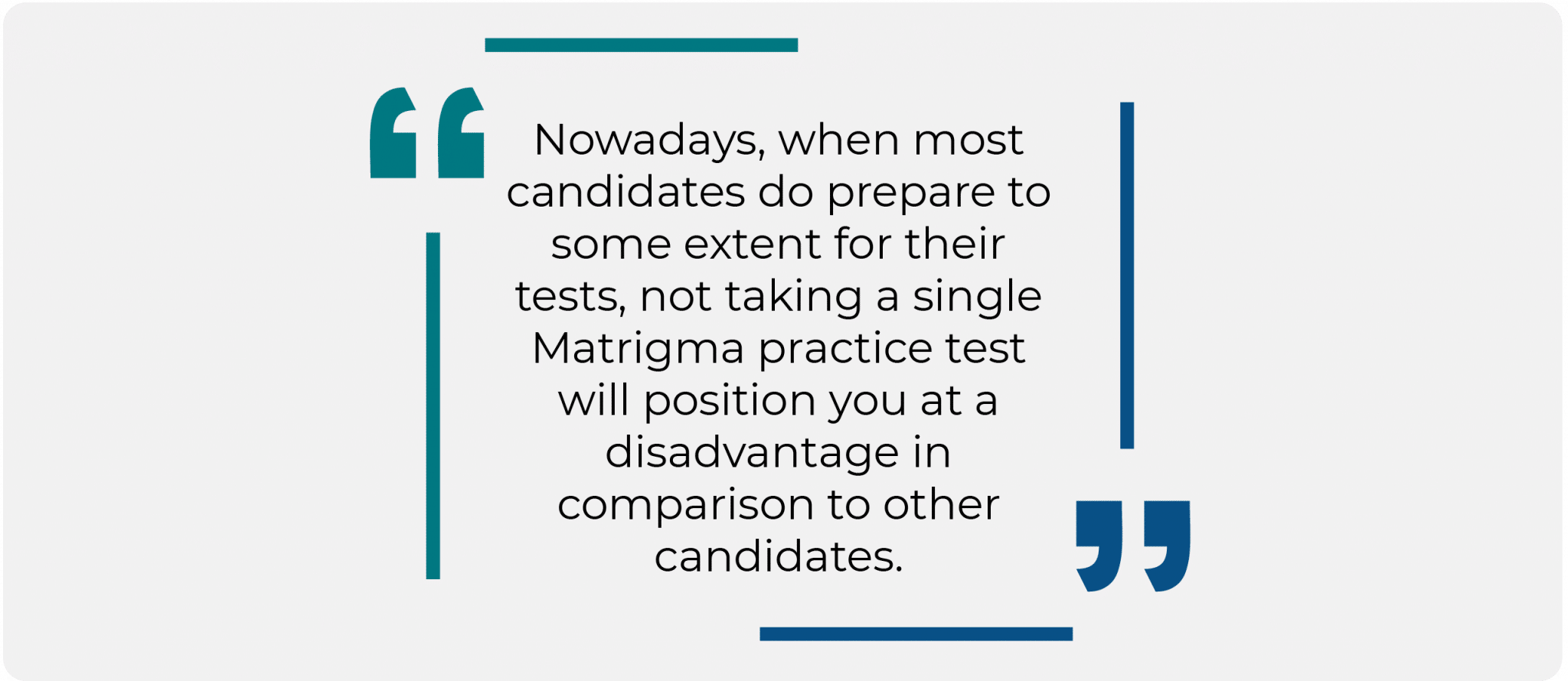
Svenska Kunder
Hej. Det är sant – den här hemsidan är skriven på engelska och övningsmaterialet är också skrivet på engelska. Vi vill däremot försäkra dig om att du är på rätt plats.
Om du letar efter Matrigma-övningsprov, är det här den plats där du hittar den mest exakta simuleringen av det riktiga Matrigma-provet från Assessio. Övningsproven kommer även med en enkel och insiktsfull guide över hur du bör gå tillväga för att göra provet. Dessutom följs varje fråga av en detaljerad förklaring som avslöjar matrixens underliggande logik med ett enkelt och intuitivt språk.
Vi erbjuder även en pengarna-tillbaka-garanti, utan att ifrågasätta. Så ta den här chansen att förbereda dig för och göra bra ifrån dig på Matrigma-provet på första försöket.
Du är välkommen att prova några av de kostnadsfria Matrigma-övningsproven på den här sidan.
Information Sources
Disclaimer – All the information and prep materials on iPrep are genuine and were created for tutoring purposes. iPrep is not affiliated with Assessio International, which is the owner of Ascend and the Matrigma Test.
Free Matrigma practice test: Get to know what the Matrigma Test will be like by practicing with these sample questions:
Question 1 of 5
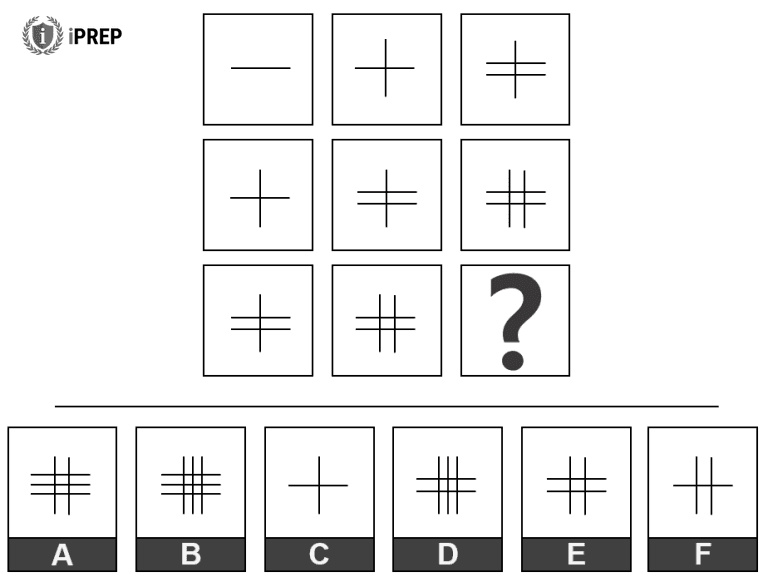
The correct answer is A.
Starting at the top left box, in each “step” (to the box on the right or down below) another line is added to the element. The addition alternates between vertical and horizontal lines. As the second box on the right includes two horizontal lines and two vertical lines and the last line to be added was a vertical line, a third horizontal line must be added to the missing element.
Question 2 of 5
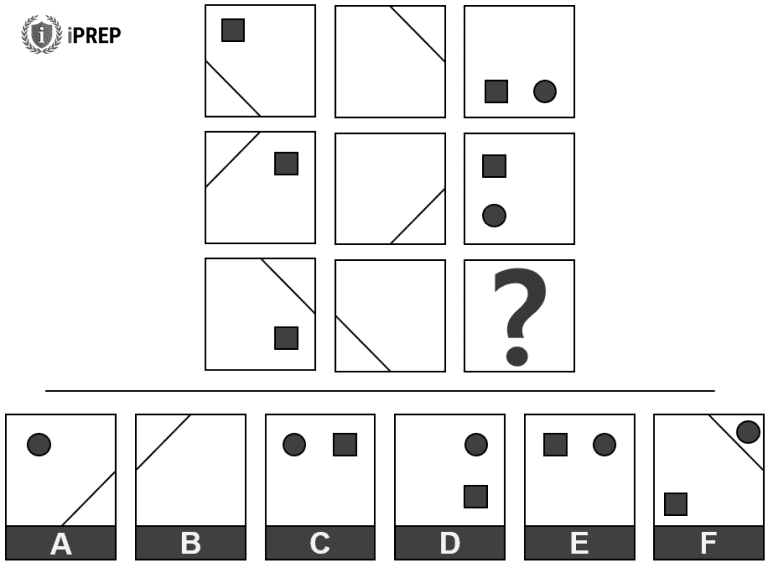
The correct answer is C.
This matrix follows a logic by columns. Each column consists of elements with a similar pattern. From top to bottom, each element rotates 90° clockwise.
Question 3 of 5
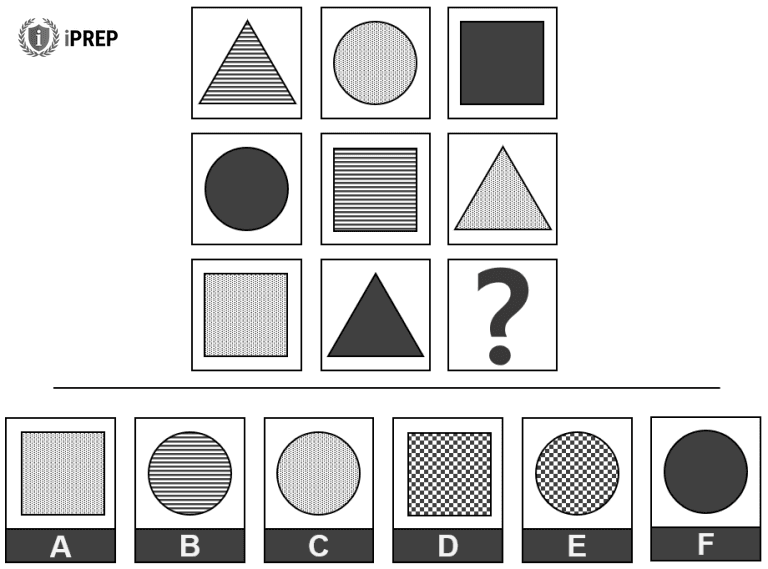
The correct answer is B.
The shapes of the matrix are either a triangle, a square, or a circle. Each shape is filled with some pattern, either solid dark grey, dotted or striped. Each column and each row of the matrix includes all three types of shapes and all three types of pattern fill. Therefore, the missing element must be a striped circle.
Question 4 of 5
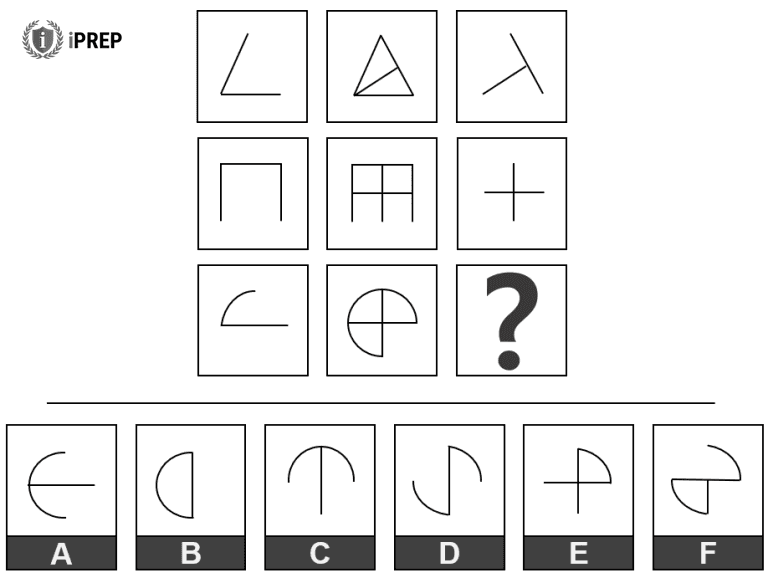
The correct answer is D.
The logic of this matrix is only governed by the logic of the rows. The middle element of each row is the combination of the right and left elements, placed one on top of the other.
Question 5 of 5
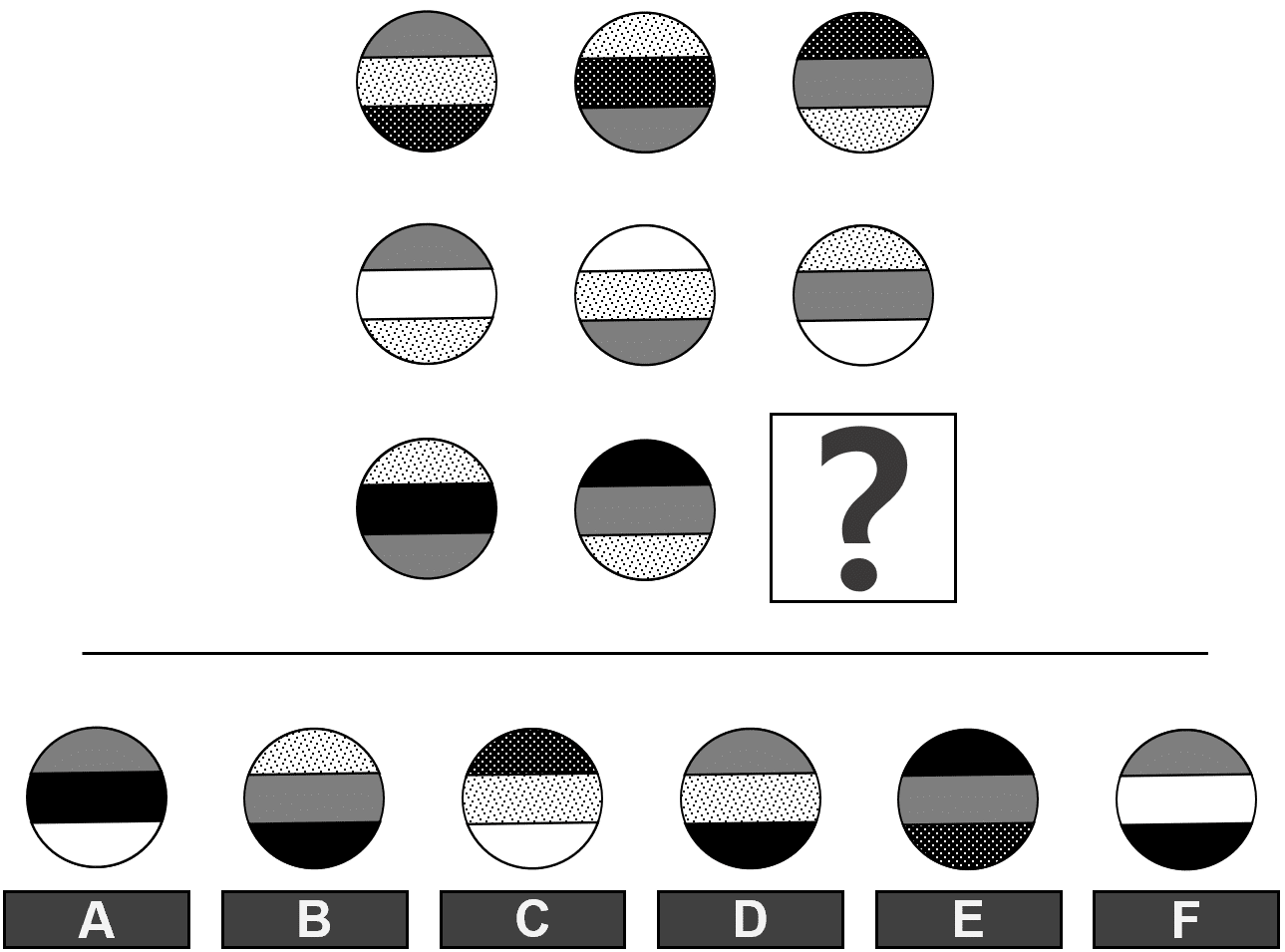
The correct answer is D.
This matrix can be solved by understanding the logic of the rows.
Each element is a circle divided into three sections. Each of these sections is filled with different colors and patterns, each pattern appearing once in every element.
In each row, from left to right:
- The pattern on the bottom becomes the pattern in the middle in the next element.
- The pattern in the middle becomes the pattern on the top in the next element.
- The pattern on the top becomes the pattern on the bottom in the next element.
It is easiest to see this pattern if you look diagonally from the bottom section of the left element to the top section of the right element
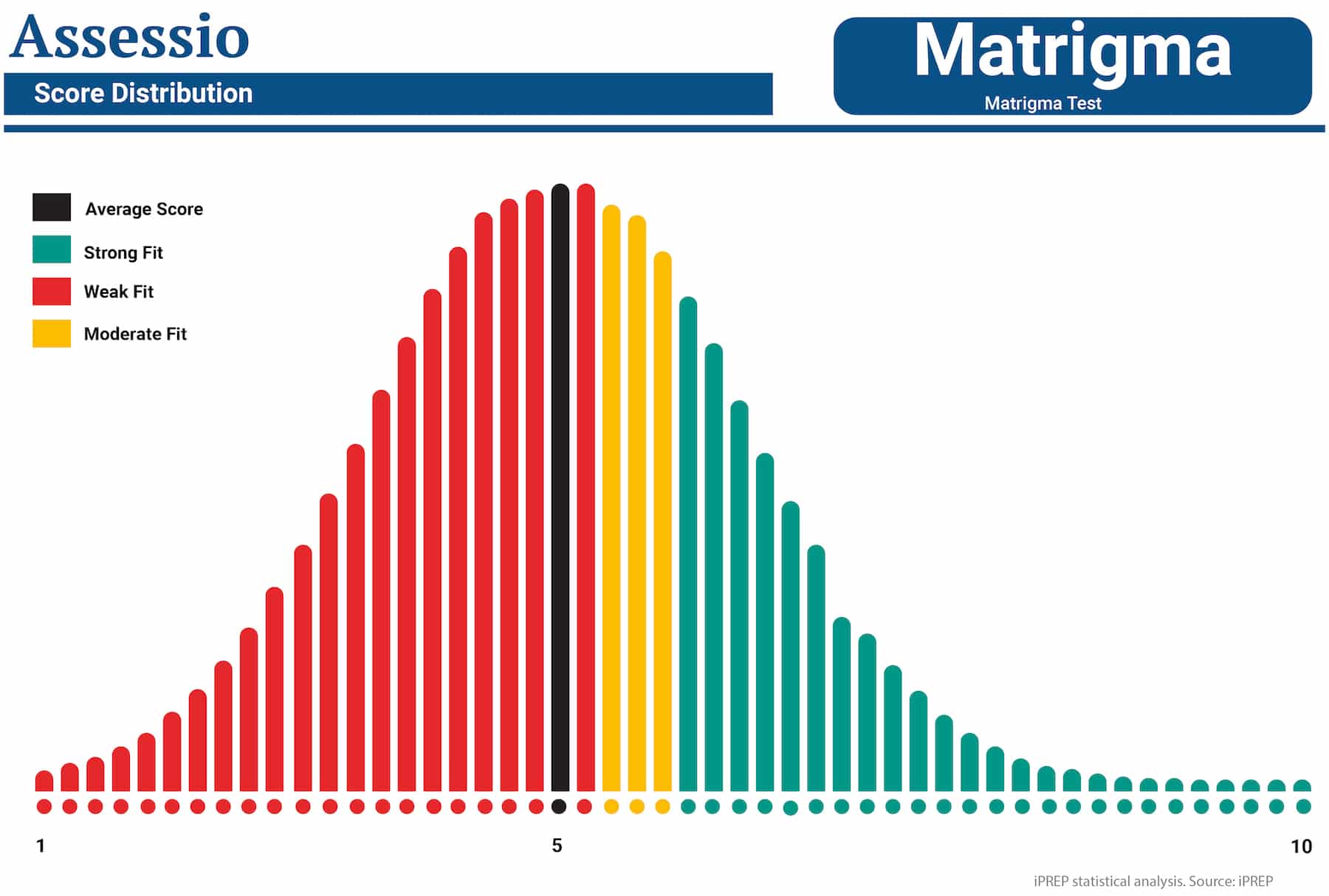
Well done!
You have completed the Sample Questions section.
The complete iPREP course includes full test simulations with detailed explanations and study guides.
‘…TESTS THAT ACTUALLY HELP’

In the first 30 minutes of use I have learned so much more than skipping along the internet looking for free content. Don’t waste you time, pay and get tests that actually help.
Richard Rodgers
January 28, 2020 at 7:49 PM
About the course
Languages: 🇺🇸 🇸🇪 🇳🇴 🇳🇱 (beta, auto-translated)
This course will help you upgrade your Matrigma matrix-solving skills in less than five hours! Through this course, you will quickly review the essentials of matrix-solving strategies and understand what to expect on the Matrigma, a matrix-based test.
The course is comprised of both practice and learning sessions. But first, you will go through a sample test to get a feel for the challenge ahead. In it, you will answer questions within a time limit. Once done, you will have the option to review your answers and question explanations.
5
Learning hours
4
Practice tests
165
Questions
150
Videos
Following the test experience, we will guide you through learning lessons with essential information about your upcoming Matrigma test. These lessons will help you understand the underlying techniques that are essential for succeeding in the test.
The course is then concluded with four full-length simulations that accurately follow the structure and concepts of the Classic Matrigma Test. Once you submit each of the tests, you will be able to get a test summary and even see how well you performed in comparison to other people who have taken the test.
A unique feature to iPrep – You will also be able to access the practice tests in the Adaptive Matrigma format. While in this format we cannot guarantee that the score report is comparable with the real test, your test experience will be exactly the same.
Skills you will learn
Abstract-reasoning
Logical-thinking
Inductive-reasoning
Problem-solving
Curriculum
- Course Introduction
- Inductive & Abstract Reasoning Warm-Up
- The Basic Structure of The Matrix
- Matrix Problems Warm-Up
- Deciphering the Logic → Solving the Matrix
- Time Management Essentials
- Matrigma-Style Simulations – Test Yourself
- Course Conclusion
About the author

M.A. Tamir Rubin
Psychology and Cognitive Sciences Expert
Tamir Rubin has been working in the field of Psychology and Cognitive Sciences for over ten years. His experience includes the development of tens of assessment test preparations in subjects such as Abstract Reasoning, Cognitive Ability, Critical Thinking, Deductive Reasoning, Inductive Reasoning, Numerical Reasoning, Verbal Reasoning, and more.
Rubin has been the Head Of Products for TestPrep, a global leader in assessment test preparation, and holds a Master’s degree from the Bar-Ilan University and a Bachelor’s degree from the Hebrew University.
Customer Testimonial

Thanks to this prep course, I was able to pass the test on my second attempt and was able to continue my interview process with the company.
James Swanson
July 30, 2019 at 1:09 PM
Reviews

Karoline S********
June 20, 2025 at 12:07 PM
Fin måte å bli kjent med testen, gode forklaringer. Kunne hatt noen flere øvingsoppgaver. Hadde vært fint med noen nye oppgaver til adaptiv test etter å ha gjennomført den klassiske.

Soledas A******
May 29, 2025 at 8:48 PM
Great training for before a real test for a job, thank you! Great training and testing several times and a lot of repetition

Jeanette K**********
May 25, 2025 at 6:37 PM
I recommend it if you haven't done these kind of tests in a while. It helped me a lot to understand the logic behind these figures.

Ingeborg W****
May 5, 2025 at 6:35 PM
The best! excellent videos and explanations! Also, it includes much complex escenarios that I did not find in other online courses!

Fabian T***
March 18, 2025 at 6:10 AM
This course is great if you feel insecure about your ability to solve matrigma style tests. You get detailed explanations for all the different ways to solve them and a lot of possibilities to practice and improve your skills with "real" tests. Absolutely recommend!

Chris S******
February 11, 2025 at 7:46 PM
An excellent course, well worth investing in this before doing the Matrigma. It contains practice tests and also excellent tutorial videos that explain the answers to the practice tests. It will help you become familiar with the test style and strategies to work out the answers, and gives you confidence when you come to take the real test.

André P******
January 18, 2025 at 9:43 AM
The course is built logical and comprehensive with an effective mixture of practice and explanation. It increases understanding and confidence to remain calm in the test.

Vasileios B***********
December 12, 2024 at 9:26 AM
Great material for anyone needing a quick preparation for a job interview! You might hear that practice doesn't help improve your score at Matrigma tests, but I have clearly improved mine after taking this course.

Emil B********
November 17, 2024 at 2:28 PM
This course is just what I needed. I have been out of school for over twenty years and this iPrep course helped me get prepared for the aptitude test! Thank you so much!

Gregory E***
November 5, 2024 at 10:28 AM
The product was extremely helpful and provided great insights; I would definitely recommend it to others. It made a significant impact on my preparation for an upcoming test.
